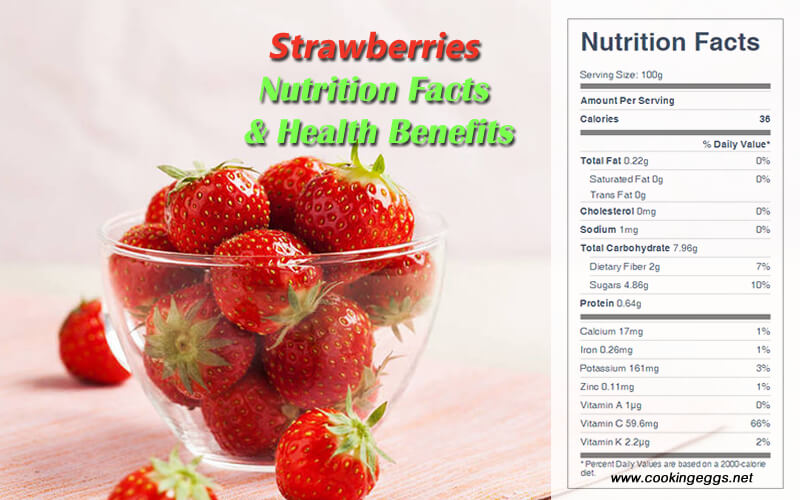Strawberries Nutrition Facts & Health Benefits
Strawberries are widely appreciated for their characteristic aroma, bright red color, juicy texture, and sweetness. They can also form a consequential component of the diet and turn into a potential source of functional foods and nutraceuticals due to their antioxidant capacity and nutritional quality.
Raw strawberries are 91% water, 8% carbohydrates, 1% protein, and contain negligible fat. Strawberries are a rich source of vitamin C, a good source of manganese, and provide several other vitamins and dietary minerals in small amounts. Strawberries contain a modest amount of essential unsaturated fatty acids in their achene (seed) oil.

The nutritional composition of strawberries
The color in strawberries is generated by the accumulation of anthocyanins and polyphenolic compounds. In terms of nutrition, strawberries are good sources of ascorbic acid (AA) (vitamin C), tocopherol (vitamin E), beta-carotene, melatonin, and other polyphenolic compounds such as flavan-3-ols, ellagitannins, cinnamic acid conjugates, flavanols, and ellagic acid conjugates.
One cup of raw strawberries provides 45 calories, 10.5 g carbohydrate, 0.9 g protein, 0.6 g fat, 3.4 g dietary fiber, 40 IU vitamin A, 84 mg vitamin C, 26 mcg folic acid, 247 mg potassium, 1 mg sodium, 28 mg phosphorus, 21 mg calcium, and 15 mg magnesium.
Raw Strawberries Nutrition Facts Label
Health Benefits of Strawberries
The importance of fruit intake to either promote or prevent diseases is well known. Berries are generally "small fruits" and include strawberries, blueberries, raspberries, blackberries, cranberries, and others. Due to the nutritional properties and bioactive principles of fruits, they play an important role in human nutrition and health. Epidemiologic studies have shown that a diet with adequate fruits and vegetables is often associated with a lower incidence of chronic diseases, including obesity, diabetes type II, infections, cardiovascular diseases, neurologic diseases, and cancer.
Garden strawberries contain the dimeric ellagitannin agrimoniin, which is an isomer of sanguiin H-6. Other polyphenols present include flavonoids, such as anthocyanins, flavanols, flavonols and phenolic acids, such as hydroxybenzoic acid and hydroxycinnamic acid. Strawberries contain fisetin and possess higher levels of this flavonoid than other fruits. Although achenes comprise only about 1% of the total fresh weight of a strawberry, they contribute 11% of the total polyphenols in the whole fruit; achene phytochemicals include ellagic acid, ellagic acid glycosides, and ellagitannins.
Although strawberries don’t pack the anthocyanin punch of some of the purple fruits and berries, they do contain at least two anthocyanins, and they are an excellent source of a variety of other flavonoids, including catechin, quercetin, and kaempferol, as well as vitamin C, potassium, beta-carotene, and lutein. They also contain ellagic acid, which is a potent anticancer compound.
The consumption of strawberries affects, theoretically, the pathways relevant to cardiovascular health by several different mechanisms, one of which is antioxidation. The addition of berries to the diet can markedly reduce the risk of CVD by inhibiting inflammation, improving endothelial function, inhibiting platelet aggregation, improving the plasma lipid profile, modulating the eicosanoid metabolism, free radical scavenging, and increasing low-density lipoprotein (LDL) resistance to oxidation.
Some epidemiologic observations have also indicated that strawberries may have particular beneficial effects on the cardiovascular system, especially in women. With higher intakes of strawberries (at least two servings per week), women’s CVD risk decreased significantly and reached a borderline compared with those who didn’t consume strawberries at all.
Strawberry consumption could reduce lipids to protect LDL from oxidation and attenuate meal-induced inflammation, which is coincident with improved insulin sensitivity.
Strawberries also have a proven reputation for combating high blood pressure, and they are recommended in European traditional medicine for the elimination of kidney stones.
Their high iron content makes them therapeutic for anemia and fatigue. People with skin problems should enjoy plenty of this wonderful fruit, which cleanses and regenerates the intestinal flora. For full therapeutic effect, strawberries should be eaten on their own or at the start of a meal.
Moreover, various studies have demonstrated that berries have potential cancer chemopreventive activities as well. Great emphasis of evidence has been particularly put on the efficacy of strawberries and black raspberries in inhibiting different types of cancer cell transformation and proliferation in vitro, and in decreasing the early and late progression of experimentally induced tumors in animal models. A little, but unequivocal, evidence indicates that strawberry and black raspberry extracts can protect against carcinogens based on human subject clinical trials.
Health Risk
Some people experience an anaphylactoid reaction to eating strawberries. The most common form of this reaction is oral allergy syndrome, but symptoms may also mimic hay fever or include dermatitis or hives, and, in severe cases, may cause breathing problems. Proteomic studies indicate that the allergen may be tied to a protein for the red anthocyanin biosynthesis expressed in strawberry ripening, named Fra a1 (Fragaria allergen1). Homologous proteins are found in birch pollen and apples, suggesting that people may develop cross-reactivity to all three species.
White-fruited strawberry cultivars, lacking Fra a1, may be an option for strawberry allergy sufferers. Since they lack a protein necessary for normal ripening by anthocyanin synthesis of red pigments, they do not turn the mature berries of other cultivars red. They ripen but remain white, pale yellow, or "golden," appearing like immature berries; this also has the advantage of making them less attractive to birds. A virtually allergen-free cultivar named "Sofar" is available.